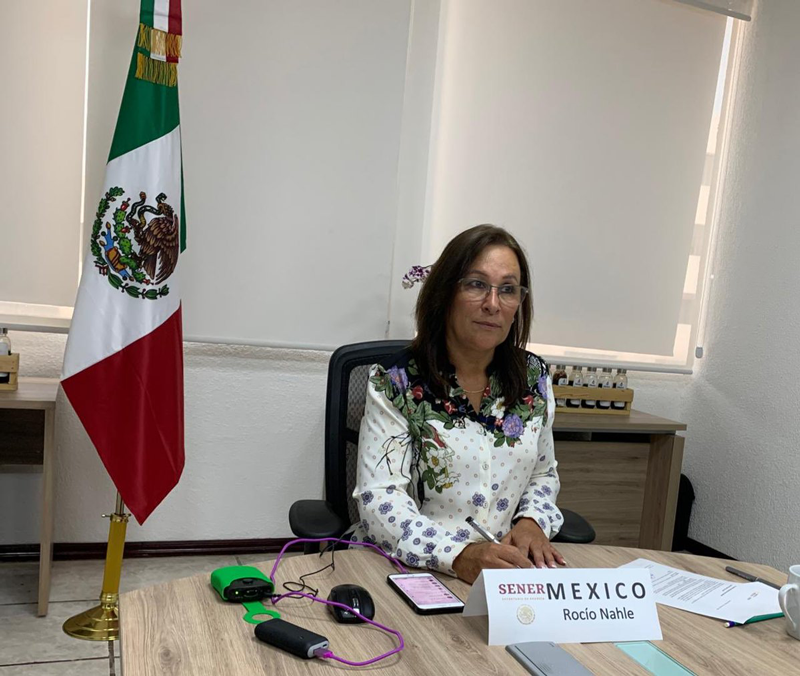Since his inauguration in 2018, President Andrés Manuel López Obrador (known as AMLO) defined the guidelines of his oil and hydrocarbons policy for the next six years with a fundamental purpose of strengthening Mexico’s energy security, increasing oil extraction and gasoline production, and thus reducing the import of the product that reached 350,000 barrels per day, about 77 percent of the domestic consumption.
The main line of action in his energy strategy was related to Petróleos Mexicanos, the state-owned petroleum company – more commonly referred to as PEMEX – which had the highest level of indebtedness in its history with $100 billion and the lowest level of crude oil extraction of the century, at less than two million barrels per day, far below the 3.8 million bbl/d reached in 2004, and in continuous decline since 2012. Its six refineries were only working at 38 percent of the installed capacity and with obvious signs of obsolescence and deterioration.
The situation required the implementation of immediate measures, some of them highly technical and complex, others politically unpopular. With that in mind, the Secretaría of Energía (SENER), Mexico’s ministry of energy, needed to be under the administration of someone with the necessary technical knowledge and political experience. AMLO appointed Norma Rocío Nahle García, believing her to be the most suitable person.

Nahle is a chemical engineer with a specialty in petrochemistry from the Universidad Autónoma of Zacatecas, with degrees in Chemical Process Engineering, Economic Engineering and Strategic Analysis from UNAM. She is a member of the Committee for Energy Studies for Latin America and the Caribbean (CNEE), and has been part of PEMEX in different areas. Her political career includes advisor on energy affairs for the Chamber of Deputies and Senate of the Republic, member of the Energy Commission of the Latin American Parliament, Secretary of the Energy Commission in the Congress of the Union, and current Senator for the Morena party, representing the state of Veracruz. She was the Secretary of Energy from November 2018 to October 2023, when she stepped down to campaign for governor of Veracruz in the 2024 elections.
One of her main achievements as Secretary was the reformulation of the exploration and exploitation policy: Ending the oil rounds (the participation of private capital in the extraction and sale of crude oil) and not awarding any more fields to private companies, retaking control of almost 95 percent of the sector.
PEMEX, after the new oil and gas policy, recovered the three main fuels markets: Gasoline had an annual growth of 20 percent in sales, jet fuel an increase of 72 percent, and diesel 41 percent. Nahle said that limiting the participation of private companies in the sector was the best decision. “Out of 110 contracts, only 10 or 12 are actually investing in the exploration of new deposits,” she said in an October 2023 interview with Mexico’s Expansión magazine.
Another accomplishment was the reconditioning of the infrastructure and improvement of the installed capacity of PEMEX. Nahle mentioned that the current government received the refineries working at 38 percent of their capacity in 2018. Today, they are working at 65 percent and the plan is to increase their capacity to 80 percent.
“They really were abandoned, and we have invested $3.4 billion in their maintenance and readaptation.” Nahle says. In December 2021, PEMEX acquired full ownership of Deer Park refinery located in Texas, processing 26 percent of the total crude that Mexico processed during the first half of 2022.
But, without a doubt, Nahle’s main infrastructure project was the construction and commissioning of the Olmeca Refinery, located in the port of Dos Bocas, Tabasco. Its construction began on August 1, 2019, and it was inaugurated on July 1, 2022. With a final cost of $20 billion (considerably more than the original projection of $9 million), the Olmeca or Dos Bocas refinery was built on a 586-hectare site, consists of 93 storage tanks, 24 spheres, 17 processing plants, water treatment plants, and includes green and conservation areas. Dos Bocas will be able to refine more than 340,000 barrels of oil per day during 2024, as well as produce gasoline, diesel, jet fuel, asphalt and liquefied gas, among others.
Nahle mentioned that the project generated 200,000 direct and indirect jobs. She highlighted the participation of women, stating, “Women in Dos Bocas? Yes, 14 percent of the onsite workforce are blue-collar workers, doctors, engineers, welders, accountants and warehousemen. [It is] a privilege to have them. The intelligence and dedication of Mexican women are essential in this work, and they are part of the great talent and most important resource of Dos Bocas: its people,” Nahle concluded.
Following her resignation, Miguel Angel Maciel was named the new Energy Secretary. He is a petroleum engineer and the former undersecretary for hydrocarbons. He worked more than 30 years for PEMEX, in exploitation and production areas.
“Miguel Angel has all our trust for his honesty and proven convictions in favor of national sovereignty,” President López Obrador declared.
With another year left to complete his six-year term, AMLO considers that the continuity of the current energy policy necessary for the future of the sector, and Claudia Sheinbaum, the official candidate for the presidency of the government party, will guarantee its stability in the future.

Sheinbaum studied physics and has a master’s degree and a doctorate in energy engineering and conducted her doctoral research at Berkeley. She was an advisor to the National Commission for Energy Saving and the Federal Electricity Commission, and, internationally, a consultant to the World Bank and the United Nations Development Program (UNDP). She participated in the development of methodologies that allowed the authorities in Mexico City to measure pollution and create an alert system and establish environmental contingency measures, and during her tenure as mayor of the capital, she expanded the low emission public transportation network (Metrobus, Trolleybus, bike lanes).
Sheinbaum spoke out in favor of maintaining support for public companies, such as PEMEX and the Federal Electricity Commission (CFE), and against privatization, after referring to the fact that opposition parties long for the neoliberal model. Although she promised to deepen the policies of López Obrador’s government, she also outlined courses of action that distance themselves from the President, such as the transition of the country toward clean energies and strengthening scientific and technological development, two subjects absent in the outgoing administration.
Another presidential contender, Xóchitl Gálvez, a senator backed by a coalition of opposition parties, is a computer engineer from the University of Mexico, who specialized in robotics, artificial intelligence, smart buildings, sustainability and energy savings. Gálvez is using her platform to propose a radical reform of PEMEX, opening the market to national and international private investment and stock market listing, in addition to sustainable policies that prioritize the care of the environment.
“Mexico does not have the resources on its own to transform its energy sector and economy, and private investment must be welcomed to accelerate development responsibly.”

Gálvez says she would like to reopen the oil bidding rounds that AMLO halted after taking office in 2018. She is also an advocate of renewable energy and would look to invest in hydrogen, solar energy, and other clean energy sources, in a rollback of some of López Obrador’s current policies.
Both candidates emphasize the necessary transformation of energy production toward renewable energies and leaving behind an energy policy based mainly on oil. There are numerous challenges facing both, not only transforming the energy sector, but also improving the quality of life of the Mexican people. As a new day dawns on Mexico’s energy industry, all indications are that the presidential seat will be occupied by a woman for the first time in the country’s history.
Sources:
Latin Energy Group Magazine. “Rocío Nahle resigns.” (October 10, 2023.)
Diana Nava. “Time will prove we are right.” Interview with Rocío Nahle. México Expansión Magazine. (November 6, 2023.)
Arturo Solís. “Dos Bocas Refinery will cut gasoline import in half this year.” Bloomberg online. (September 13, 2023.)
Olivia Vázquez Herrera. “Rocío Nahle’s Degrees.” infoabe.com/México. (October 17, 2023.)
“Deer Park Refinery is already owned by the nation: AMLO.” www.capital21.cdmx.gob.mx. (September 20, 2023.)
Secretary of Energy. Dos Bocas Refinery. www.gob.mx. (September 2023.)
Headline photo: Former Secretary of Energy Norma Rocío Nahle García.
Angela Levy was born in Colombia and became a U.S. citizen in 2012. She is now a dual citizen of the two countries. She holds two master’s degrees, an MBA and another in accounting. Levy worked as a production engineer in Colombia before moving to the U.S., where she worked in the finance and accounting group at Halliburton for a decade. She later worked with special needs children for five years. Levy now spends her time traveling the western U.S.
Carlos Arturo Toro is a native of Colombia. An economist, he holds a master’s degree in finance. For more than 15 years, he was dedicated to the banking sector, as a credit analyst for Banco Popular de Colombia and as the national director of credit of various financial institutions. For several years after finishing his career in the banking sector, Toro worked as a tropical glacier guide and, periodically, as a volunteer park ranger for the Colombian National Park.
Oil and gas operations are commonly found in remote locations far from company headquarters. Now, it's possible to monitor pump operations, collate and analyze seismic data, and track employees around the world from almost anywhere. Whether employees are in the office or in the field, the internet and related applications enable a greater multidirectional flow of information – and control – than ever before.


